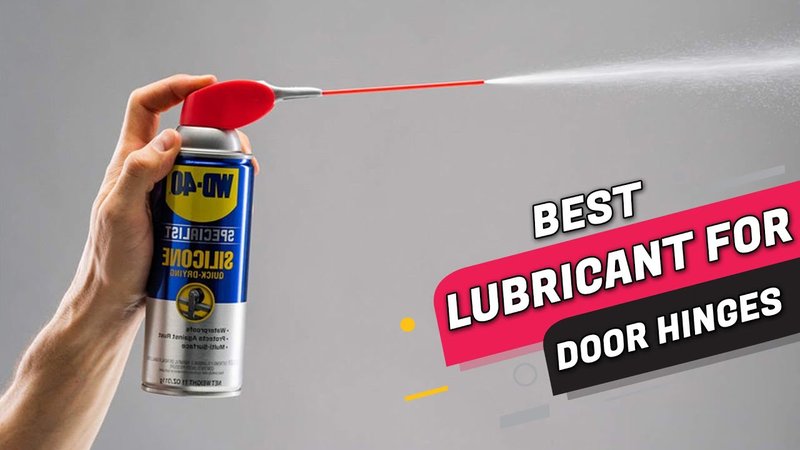
Let’s break down the types of lubricants that work best for various climates. We’ll explore how humidity and dryness can affect your door hardware, and how choosing the right lubricant can make a world of difference. From silicone sprays that repel moisture to graphite powders that thrive in arid conditions, we’ll help you find the best solution for your specific environment.
Understanding Humid Climates and Their Impact on Door Hardware
Humidity brings a unique set of challenges for door hardware. When the air is moist, metal parts can corrode, rust, and become sticky. Think of it as your door hardware getting a little too cozy with the dampness, which can lead to stubborn hinges and latches. The constant exposure to moisture creates a perfect environment for rust to thrive.
To combat this, you need a lubricant that not only reduces friction but also forms a protective barrier against moisture. Silicone-based lubricants are often the go-to choice in these situations. They’re water-resistant and create a slick, long-lasting film that helps prevent rust and oxidation. It’s like putting on a raincoat—you stay dry, even in a downpour.
Why Choose Silicone-Based Lubricants
Silicone-based lubricants excel in humid conditions for several reasons:
- Water-Resistant: They repel water and prevent it from penetrating metal surfaces.
- Durable: Silicone lubricants tend to last longer than other types, reducing the frequency of application.
- Versatile: They work well on different materials, including metal, plastic, and rubber.
So, if you live in a place where summer humidity makes everything feel sticky, a good silicone lubricant will keep your door hardware gliding smoothly, even when the weather tries to throw a wrench in the works.
Best Lubricants for Humid Conditions
If you’re dealing with humidity, there are a few standout products to consider:
1. WD-40 Specialist Silicone:
– It’s water-resistant and provides a protective layer that keeps moisture out.
2. Blaster Silicone Spray:
– This option is ideal for metal and plastic surfaces, providing a long-lasting shield against rust.
3. DuPont Teflon Silicone Lubricant:
– With Teflon, this lubricant not only protects but also reduces friction, making it easier for your doors to operate smoothly.
These lubricants tackle the challenges posed by humidity effectively. When applied correctly, they can significantly extend the life of your door hardware.
Challenges of Dry Climates for Door Hardware
Now, let’s flip the script and look at dry climates. In these regions, lack of moisture can lead to different complications. Picture a squeaky door that you’ve been ignoring; the dryness causes the metal components to wear down, leading to metal-on-metal contact that creates friction and noise. Here’s the deal: you can end up with a stubborn door that’s hard to open.
In dry conditions, the right lubricant can make all the difference. You want something that not only reduces friction but also provides a lasting film to protect against wear. This is where graphite powder comes into play. Unlike liquid lubricants, graphite powder doesn’t attract dust or debris, making it ideal for areas that tend to be dry and dusty.
Why Use Graphite Powder
Graphite powder provides several advantages in dry climates:
- No Attractants: It doesn’t attract dirt, keeping your hardware cleaner for longer.
- Long-Lasting: A small amount goes a long way, and it doesn’t wear off easily.
- Effective Lubrication: It excels at reducing friction without causing buildup.
So, if you find yourself in a dry environment where dust and wear are constant concerns, graphite powder could be your best friend.
Best Lubricants for Dry Conditions
Here are some top picks for dry climates:
1. CRC Dry Graphite Lube:
– This dry lubricant is perfect for metal surfaces, providing a long-lasting barrier without attracting dust.
2. DuPont Teflon Dry-Film Lubricant:
– Another great choice, it offers excellent lubrication and protects against wear without leaving a messy residue.
3. 3M Dry Film Lube:
– This product is simple to use and offers a lasting lubricating film, ideal for hinges and locks.
These lubricants can help your doors operate effortlessly, even in the harshest of dry conditions.
Choosing the Right Lubricant for Your Specific Needs
When it comes to selecting the right lubricant for your door hardware, consider where you live and how the climate impacts your hardware. You might be wondering how to decide. Here’s a simple breakdown:
– Humidity: Look for silicone-based lubricants to repel moisture and resist rust.
– Dryness: Opt for graphite powders to reduce friction and avoid attracting dust.
It’s all about understanding the environment and selecting a product that matches those conditions.
Application Tips for Maximum Effectiveness
Once you’ve chosen the right lubricant, proper application is key. Here are some steps to ensure you’re applying it effectively:
1. Clean the Area: Start by cleaning the door hardware with a cloth to remove any dust or old lubricant.
2. Apply Sparingly: Less is often more. A small amount of lubricant goes a long way, so don’t overdo it.
3. Work it In: Open and close the door several times after applying the lubricant to help it penetrate and distribute evenly.
Following these simple steps will ensure your door hardware remains in top shape no matter the weather.
Final Thoughts
Choosing the right lubricant for your door hardware isn’t just about keeping it functional; it’s about prolonging its life and saving you from future headaches. Whether you’re protecting against humidity or dust, there’s a product out there tailored to your needs. Remember, the climate can have a significant impact on how your hardware operates. By understanding that and choosing wisely, you can ensure your doors always perform at their best. So next time you reach for that can or tube of lubricant, you’ll know exactly what to pick based on your environment.
